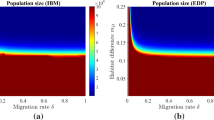Abstract
A deterministic mathematical model is developed for competition between two plant species (or genotypes) in the presence of a host-specific pathogen capable of attacking one of the species only. The complexity of the plant-plant-pathogen interaction precluded precise mathematical description of all possible long-term outcomes. However, extensive computer simulation shows that stability is not an inevitable consequence of the differential interaction, rather, the outcome depends greatly upon the growth rates and relative competitive abilities of the plant species and on the transmission efficiency of the pathogen and its effect on individual host plants. The model confirmed the general validity of previous intuitive arguments but clearly indicated that the occurrence of inflected yield curves is not a sufficient indication in itself of long-term stability.
Similar content being viewed by others
References
Alexander HM, Burdon JJ (1984) The effect of disease induced by Albugo candida (white rust) and Peronospora parasitica (downy mildew) on the survival and reproduction of Capsella bursa-pastoris (shepherd's purse). Oecologia (Berlin) 64:314–318
Anderson RM (1981) Infectious disease agents and cyclic fluctuations in host abundance. In: Hiorns RW, Cooke D (eds) The Mathematical Theory of the Dynamics of Biological Populations II. Academic Press, London
Braakhekke WG (1980) On coexistence: a causal approach to diversity and stability in grassland vegetation. Agricultural Research Report. No. 902, CABO, Wageningen
Browning JA (1974) Relevance of knowledge about natural ecosystems to development of pest management programs for agroecosystems. Proc Amer Phytopathol Soc 1:191–199
Burdon JJ (1982) The effect of fungal pathogens on plant communities. In: Newman ET (ed) The Plant Community as a Working Mechanism. Special publication, British Ecological Society No. 1, pp 99–112
Burdon JJ, Chilvers GA (1977) The effect of barley mildew on barley and wheat competition in mixtures. Aust J Bot 25:59–65
Burdon JJ, Groves RH, Cullen JM (1981) The impact of biological control on the distribution and abundance of Chondrilla juncea in south-castern Australia. J Appl Ecol 18:957–966
Burdon JJ, Groves RH, Kaye PE, Speer SS (1984) Competition in mixtures of susceptible and resistant genotypes of Chondrilla juncea differentially infected with rust. Oecologia (Berlin) 64:199–203
Burdon JJ, Shattock RC (1980) Disease in plant communities. Applied Biology 5:145–219
Burdon JJ, Whitbread R (1979) Rates of increase of barley mildew in mixed stands of barley and wheat. J Appl Ecol 16:253–258
Burleigh JR, Roelfs AP, Eversmeyer MG (1972) Estimating damage to wheat caused by Puccinia recondita tritici. Phytopathology 62:944–946
Chilvers GA, Brittain EG (1972) Plant competition mediated by host-specific parasites — a simple model. Aust J Biol Sci 25:749–756
De Benedictis PA (1977) The meaning of a measurement of frequency — dependent competition. Ecology 58:158–166
Ennik GC (1960) De concurrentie tussen witte klaver en Engels raaigras bij verschillen in lightintensiteit en vochtvoorziening. Jaarb Inst Biol Scheikd (Wageningen) No. 37
Harper JL (1977) Population Biology of Plants. Academic Press, London
Inouye RS, Schaffer WM (1981) On the ecological meaning of ratio (de Wit) diagrams in plant ecology. Ecology 62:1679–1681
Janzen DH (1970) Herbivores and the number of tree species in tropical forests. Am Nat 104:501–528
Kermack WD, McKendrick AG (1927) Contributions to the mathematical theory of epidemics. Proc Roy Soc Lond A 115:700–721
Klages KHW (1936) Changes in the proportion of the components of seeded and harvested cereal mixtures in abnormal seasons. J Amer Soc Agron 28:935–940
Leonard KJ (1969) Factors affecting rates of stem rust increase in mixed plantings of susceptible and resistant oat varieties. Phytopathology 59:1845–1850
May RM (1976) Simple mathematical models with very complicated dynamics. Nature 261:459–467
May RM, Anderson RM (1983) Epidemiology and genetics in the coevolution of parasites and hosts. Proc Roy Soc Lond B 219:281–313
May RM, Oster GF (1976) Bifurcations and dynamic complexity in simple ecological models. Am Nat 110:573–599
Simba L, Kort J, de Wit CT (1964) Experiments on competition as a means of detecting possible damage by nematodes. Jaarb IBS 246:119–124
Trenbath BR (1974) Biomass productivity of mixtures. Adv Agron 26:177–210
Trenbath BR (1975) The productivity of mixtures and its relation to the interaction between plant components. In: Physiological and Biochemical Basis of Interactions among Plants in Phytocoenoses. Naukova Dunka, Kiev
Trenbath BR (1976) Models and the interpretation of mixture experiments. In: Wilson JR (ed) Plant Relations in Pastures. CSIRO, Melbourne, pp 145–162
Van den Bergh JP, Braakhekke WG (1978) Coexistence of plant species by niche differentiation. In: Freysen AHJ, Woldendorp JW (eds) Structure and Functioning of Plant Populations. North-Holland Publishing Co, Amsterdam, pp 125–138
Windle PN, Franz EH (1979) Plant population structure and aphid parasitism: changes in barley monocultures and mixtures. J Appl Ecol 16:259–268
Wit CT de (1960) On competition. Verslag Landbouwkundige Onderzoekingen, No 66
Author information
Authors and Affiliations
Rights and permissions
About this article
Cite this article
Gates, D.J., Westcott, M., Burdon, J.J. et al. Competition and stability in plant mixtures in the presence of disease. Oecologia 68, 559–566 (1986). https://doi.org/10.1007/BF00378772
Received:
Issue Date:
DOI: https://doi.org/10.1007/BF00378772




